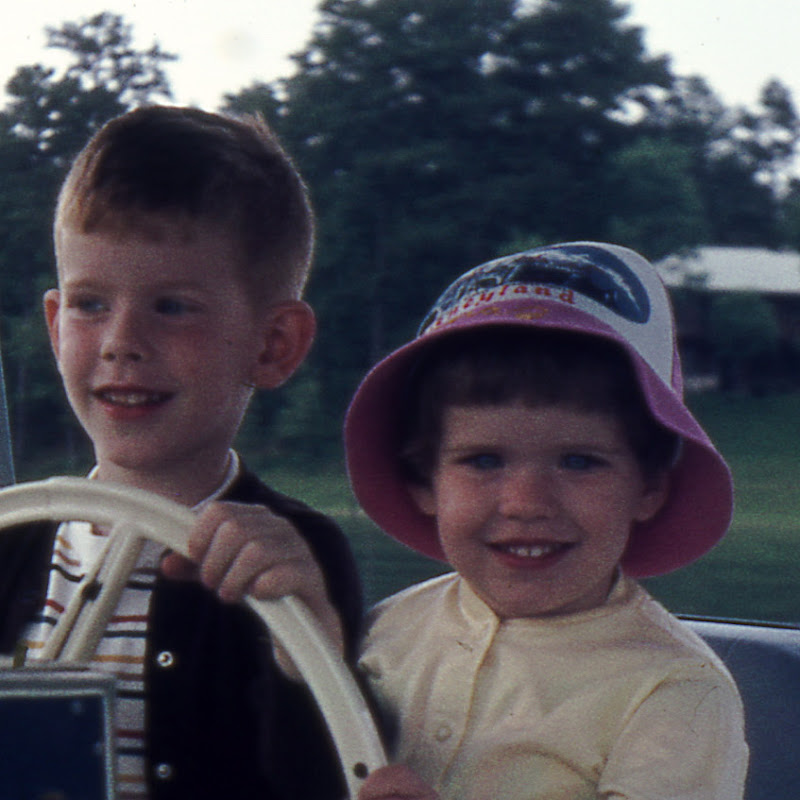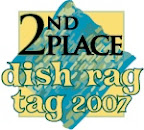Every Christmas I write about the lights -- my favorite part of the holidays. Yet as the season begins this year, I can't resist the subject again. Nothing strikes me more strongly after we set the clock back, as the darkness drops before I make my way home in the evening, than those lights. They shine on through the cold and through the gathering night, delivering a promise: You are not alone.
We put up our tree this past weekend. Not long after, we got a call from one of our neighbors -- an elderly woman who lives alone in a house a couple of doors down and across the street. She wanted to thank us for our light display. It's not much compared to others in our area -- the people in the big corner house who go all out for every holiday do about 100 times as much as we do. All we put up is a tree in the bay window and some lights on and around it. But she appreciates it, and lets us know with a call or a note each year.
I appreciate it, too. I feel a pang of sadness when we turn the lights off before bedtime, and I can't wait to see them on again in the morning. When I drive or walk home from school, which is after sunset these days, the lights greet me and lift my spirits. I'm home.
For the next month, the lights will be present anytime the sun is not. That's one reason this time of year touches me so deeply.
Wednesday, November 30, 2011
Tuesday, November 29, 2011
The big push
The cold has finally arrived in Central Arkansas. To our east and north, snow fell last night. Everywhere you look, students are wrapped in jackets and hoods, hands muffled in pockets, hats and scarfs.
It's the perfect environment for our sale to benefit Craftin' for CASA on Thursday. The sun will be out, but the air will be crisp. People will be rushing to class, to the dorm, to lunch, and they'll see colorful knitwear hanging from clotheslines around our tents. We want them to see the warmth, to anticipate feeling it around their necks or over their ears.
We have one opportunity to raise funds and raise awareness of CASA's work. And we choose to do it with the material objects we make with our own hands. There are a million details to take care of between now and the opening of the sale, and I fret over every one of them, hoping that it will all come together, wondering what I've forgotten.
But in the end, it's the cold air and the winter sun that will be our biggest allies. If people feel the cold, they will come for the warmth. If they are surrounded by bare branches, they will adorn themselves with color. If they see they can make a difference, they will contribute. All we have to do is be ready with the merchandise.
It's the perfect environment for our sale to benefit Craftin' for CASA on Thursday. The sun will be out, but the air will be crisp. People will be rushing to class, to the dorm, to lunch, and they'll see colorful knitwear hanging from clotheslines around our tents. We want them to see the warmth, to anticipate feeling it around their necks or over their ears.
We have one opportunity to raise funds and raise awareness of CASA's work. And we choose to do it with the material objects we make with our own hands. There are a million details to take care of between now and the opening of the sale, and I fret over every one of them, hoping that it will all come together, wondering what I've forgotten.
But in the end, it's the cold air and the winter sun that will be our biggest allies. If people feel the cold, they will come for the warmth. If they are surrounded by bare branches, they will adorn themselves with color. If they see they can make a difference, they will contribute. All we have to do is be ready with the merchandise.
Monday, November 28, 2011
Glistening once again
We got Christmas underway at our house at the earliest possible moment. After returning from Thanksgiving festivities on Friday, Noel gave me a couple of extra hours of sleep on Saturday morning and hauled out all the decorations in the meantime. All I had to do was assemble our little tree and recruit Cady Gray to help with the decorations.
Playing Santa was Noel's mode all weekend. He fired up the massive Christmas playlist on the iPod, set the DVR to record everything with "holiday" or "Christmas" in the description, and stacked our Christmas special DVDs high beside the television. And the spirit was infectious. Cady Gray and I started talking about the spirit of Christmas, and Archer sat raptly watching the new Elf on the Shelf special after dinner tonight. Every time a kid walks by our Christmas stockings, they can't resist jingling the little bells at the bottom.
It's a commonplace to complain about how quickly Christmas takes over the retail shelves and the Muzak airwaves. But in a year that has gone by like a flash, I suspect that the next month -- the rest of the holiday season -- will go by just as expeditiously. And I'm aiming to hold onto every precious emotion and moment of joy.
Playing Santa was Noel's mode all weekend. He fired up the massive Christmas playlist on the iPod, set the DVR to record everything with "holiday" or "Christmas" in the description, and stacked our Christmas special DVDs high beside the television. And the spirit was infectious. Cady Gray and I started talking about the spirit of Christmas, and Archer sat raptly watching the new Elf on the Shelf special after dinner tonight. Every time a kid walks by our Christmas stockings, they can't resist jingling the little bells at the bottom.
It's a commonplace to complain about how quickly Christmas takes over the retail shelves and the Muzak airwaves. But in a year that has gone by like a flash, I suspect that the next month -- the rest of the holiday season -- will go by just as expeditiously. And I'm aiming to hold onto every precious emotion and moment of joy.
Sunday, November 27, 2011
For the joy of human love, brother sister parent child
Today's post about Jacob, a boy with a story, is at Toxophily.

This hat will go to Jacob after our Craftin' For CASA sale on Thursday. I hope you'll support Jacob and the other CASA clients, all of whom have a story that is waiting to be told.

This hat will go to Jacob after our Craftin' For CASA sale on Thursday. I hope you'll support Jacob and the other CASA clients, all of whom have a story that is waiting to be told.
Saturday, November 26, 2011
And while I search for you I'll leave my door ajar
Today's post about a three-city, two-conference scarf is at Toxophily.

It rained all day today. Really hard sometimes. Guess who was thankful to be home instead of driving six hours to get home?

It rained all day today. Really hard sometimes. Guess who was thankful to be home instead of driving six hours to get home?
Friday, November 25, 2011
Thankful to be home
I've spent one night at home in the last week, so my gratitude is all about being in my easy chair, with my computer and my DVR full of my shows, in my PJs and looking forward to a hearty sleep in my own bed. Not that I should be complaining about visiting beautiful San Francisco, where I spent time with wonderful colleagues, had enriching professional experiences, and ate some lovely meals; nor about spending time with Noel's family in Nashville, where the turkey was well-brined and the long-unseen relatives were copious.
For me, however, four trips in three months is about the limit. I've been to some fabulous places and done good work, but I am ready to hibernate at home for the rest of the winter. Home is where I can spend an afternoon sewing -- where Cady Gray can choose a Perler bead or knitting project at the drop of a hat. Home is where my beloved Little Orphan Annie collections, far too heavy to take on the road, are sitting by my bed to end the day. Home is where the Christmas tree lights will soon go up. It's where there is time for all the lengthy thinking and plotting necessary to end this semester and start the next one.
Home is home base, and everyone knows that home base is where you safely rejuvenate for your next forays into the wide world. I'm thrilled to be done with the forays and in for a long round of rejuvenation.
For me, however, four trips in three months is about the limit. I've been to some fabulous places and done good work, but I am ready to hibernate at home for the rest of the winter. Home is where I can spend an afternoon sewing -- where Cady Gray can choose a Perler bead or knitting project at the drop of a hat. Home is where my beloved Little Orphan Annie collections, far too heavy to take on the road, are sitting by my bed to end the day. Home is where the Christmas tree lights will soon go up. It's where there is time for all the lengthy thinking and plotting necessary to end this semester and start the next one.
Home is home base, and everyone knows that home base is where you safely rejuvenate for your next forays into the wide world. I'm thrilled to be done with the forays and in for a long round of rejuvenation.
Wednesday, November 23, 2011
One big happy
More frequently than you might imagine, I pause and say to myself, "I'm ridiculously happy." Aristotle thought happiness was the ultimate goal of human life, because it is the only goal that is not a means to achieving another goal. And while being happy doesn't mean that you're done with life and need to stop striving, you also don't have to wait for the final moments of life to be happy.
Happiness is sometimes of your own manufacture. We seek it by bettering ourselves with education, so we are better able to appreciate and participate in the wide array of experiences the world has to offer. We hone our skills so that we can take pleasure in doing things well, and so that we can accomplish tasks that are stepping stones to other tasks that will satisfy and enrich us.
But so often happiness comes with the participation of others. We find it in relationships, which have the aura of serendipity -- this spouse, these completely unearned children, these parents. We are allowed access to the benefits of our professions when editors work with us on publications. There is happiness just in the experience of being given something. Those moments are among those that bring my happiness to remembrance.
I think about my own happiness most frequently in two distinct situations. One is when I am around my children in their happy moments -- which are nearly continuous. I remind my daughter how important her happy nature is to the happiness of others. "If you're a happy person, people want to be around you," I tell her. And I try to demonstrate and reinforce in words how pervasive and significant that can be, by being friendly to people who serve us and telling Cady Gray how a smile and the time spent to be appreciative can have a ripple effect as those others pass it on.
The other situation is when I pause in my busiest moments. A walk, a meal, a wait, a drawing of breath. I feel the expanse of my life, the people it encompasses, the ideas and beautiful objects it has generated. Sometimes I compare myself to others who have done more, affected more people, enjoy a greater abundance of the things I like and want, and that comparison is invidious; it makes me think that happiness is not yet. It's around the next career corner, it's in a bigger house, it's in another book or more acclaim or a higher status. But surprisingly, those moments occur far less than the ones where I recognize my own ridiculous happiness. I know I have far more of the good things in life than I have earned. I take a moment to feel content with it all, not as an exercise in positive thinking, but just because the realization of happiness forces itself upon me.
While at the conference these past few days, I've talked to some colleagues who are not where they hoped to be in their lives. They are having trouble in their jobs, or with their families, or with their health. Any of those misfortunes could be mine as well -- might even likely be mine, as I and those I love pass through the stages of our lives, changing along the way. I confess I fear those possibilities, and find it hard to imagine how my colleagues cope with wayward children or terminal illness or a public career setback. The flip side of a pervasive happiness is that it is never the last word.
But how do I know how I will respond when tested? Will I rise to the challenge and find a response that moves me toward that ultimate goal of happiness once again? Have I developed the capacities I recommend to my daughter to rejoice in all things? I am aware that I will not escape life without finding out. And while I don't look forward to the situations that will reveal the answers, I wonder if my happiness is really, in a literal sense, ridiculous or incomplete until they arrive.
Happiness is sometimes of your own manufacture. We seek it by bettering ourselves with education, so we are better able to appreciate and participate in the wide array of experiences the world has to offer. We hone our skills so that we can take pleasure in doing things well, and so that we can accomplish tasks that are stepping stones to other tasks that will satisfy and enrich us.
But so often happiness comes with the participation of others. We find it in relationships, which have the aura of serendipity -- this spouse, these completely unearned children, these parents. We are allowed access to the benefits of our professions when editors work with us on publications. There is happiness just in the experience of being given something. Those moments are among those that bring my happiness to remembrance.
I think about my own happiness most frequently in two distinct situations. One is when I am around my children in their happy moments -- which are nearly continuous. I remind my daughter how important her happy nature is to the happiness of others. "If you're a happy person, people want to be around you," I tell her. And I try to demonstrate and reinforce in words how pervasive and significant that can be, by being friendly to people who serve us and telling Cady Gray how a smile and the time spent to be appreciative can have a ripple effect as those others pass it on.
The other situation is when I pause in my busiest moments. A walk, a meal, a wait, a drawing of breath. I feel the expanse of my life, the people it encompasses, the ideas and beautiful objects it has generated. Sometimes I compare myself to others who have done more, affected more people, enjoy a greater abundance of the things I like and want, and that comparison is invidious; it makes me think that happiness is not yet. It's around the next career corner, it's in a bigger house, it's in another book or more acclaim or a higher status. But surprisingly, those moments occur far less than the ones where I recognize my own ridiculous happiness. I know I have far more of the good things in life than I have earned. I take a moment to feel content with it all, not as an exercise in positive thinking, but just because the realization of happiness forces itself upon me.
While at the conference these past few days, I've talked to some colleagues who are not where they hoped to be in their lives. They are having trouble in their jobs, or with their families, or with their health. Any of those misfortunes could be mine as well -- might even likely be mine, as I and those I love pass through the stages of our lives, changing along the way. I confess I fear those possibilities, and find it hard to imagine how my colleagues cope with wayward children or terminal illness or a public career setback. The flip side of a pervasive happiness is that it is never the last word.
But how do I know how I will respond when tested? Will I rise to the challenge and find a response that moves me toward that ultimate goal of happiness once again? Have I developed the capacities I recommend to my daughter to rejoice in all things? I am aware that I will not escape life without finding out. And while I don't look forward to the situations that will reveal the answers, I wonder if my happiness is really, in a literal sense, ridiculous or incomplete until they arrive.
Saturday, November 19, 2011
The next big thing
I've been going non-stop ever since I got to The Annual Meetings Hosted by AAR & SBL (their official tightrope walking title between the former "joint meetings" model and the less-integrated "concurrent meetings" model). My meetings started only an hour or so after I checked in, and didn't stop except for sleep and an early-morning workout until 2:30 pm today. Even my meals were meetings; an egg salad sandwich I wolfed down before my last two meetings today was the first food I'd eaten since arriving that wasn't connected with some work that needed to be done or some people I needed to meet with.
But I've finally reached the point where I have some breathing room. And with time to stop and reflect, I can recognize how much all that activity has accomplished. On the recommendation of the finance committee, which I chair, the board of directors voted to move forward with a socially responsible investing program. I presented my research on the annual meeting program, for only the second time in a competitive format (I've been on the program on other occasions as an invited participant). And the positive notices for that research presentation included interest from a publisher.
At this point in my career, I'm thinking a lot about what I want to do with the next few years. Because I'm on an administrative track, I can't sustain a research program indefinitely; administrative duties will take over that work time if I continue to move in that direction. So the research that I'm doing now is probably my last chance to make a scholarly contribution to my field in a sustained way.
If an agreement with a publisher comes about, if this research is validated in that way, then I will be making a plan to bring it off and put it to bed. Even though I'm at the beginning stages of the research now, and have much to learn to be able to accomplish what needs to be done, I'm thinking about it in terms of an end. Imagining the final deliverable as a book manuscript means that there would be a last chapter and a concluded process.
That would be fitting and satisfying. I'm surprised that I'm possibly on that path already; I've been proceeding with the thought that I'd need to get farther before searching for publishing partners. But that's troubling in the career sense, because I don't want this project to grow without guidance and possibly spiral unproductively -- or to succumb to the kind of perfectionism I see in my students sometimes, where if you don't finish things because they're never good enough to satisfy you, you never have to face anyone's judgment, including your own. You can pretend forever that it will be great once it's done. I've never been that way; it's why I've been able to get a lot accomplished in my career so far. I don't want to start now.
But I've finally reached the point where I have some breathing room. And with time to stop and reflect, I can recognize how much all that activity has accomplished. On the recommendation of the finance committee, which I chair, the board of directors voted to move forward with a socially responsible investing program. I presented my research on the annual meeting program, for only the second time in a competitive format (I've been on the program on other occasions as an invited participant). And the positive notices for that research presentation included interest from a publisher.
At this point in my career, I'm thinking a lot about what I want to do with the next few years. Because I'm on an administrative track, I can't sustain a research program indefinitely; administrative duties will take over that work time if I continue to move in that direction. So the research that I'm doing now is probably my last chance to make a scholarly contribution to my field in a sustained way.
If an agreement with a publisher comes about, if this research is validated in that way, then I will be making a plan to bring it off and put it to bed. Even though I'm at the beginning stages of the research now, and have much to learn to be able to accomplish what needs to be done, I'm thinking about it in terms of an end. Imagining the final deliverable as a book manuscript means that there would be a last chapter and a concluded process.
That would be fitting and satisfying. I'm surprised that I'm possibly on that path already; I've been proceeding with the thought that I'd need to get farther before searching for publishing partners. But that's troubling in the career sense, because I don't want this project to grow without guidance and possibly spiral unproductively -- or to succumb to the kind of perfectionism I see in my students sometimes, where if you don't finish things because they're never good enough to satisfy you, you never have to face anyone's judgment, including your own. You can pretend forever that it will be great once it's done. I've never been that way; it's why I've been able to get a lot accomplished in my career so far. I don't want to start now.
The existential academic
On a plane high above the desert giving way to mountains, one is as alone as it's possible to be outside of the wilderness or cloister. Yes, you're packed in an aluminum tube with a couple hundred strangers; you're even sitting cheek by jowl with them, sneaking surreptitious peeks at the crossword puzzle on which they appear to be stuck.
But your thoughts are so thoroughly your own that it can even be disturbing. The song that is running through your head (in my case, "All Kinds Of Time" by Fountains of Wayne) will be there until displaced by the noises of the terminal at your destination; it seems to pulse along with the white noise of the aircraft engines. The ideas that arise when you look out the window, or pause in your reading, or glance at the Selena Gomez movie playing in the flip-down screen that youve never heard of before (I was hoping during the opening credits that MONTE CARLO would turn out to be a sequel to GRAN TORINO) -- they are as private as they come, since there is no one with whom one is in social intercourse, and not the slightest opportunity to express them.
The most pressing decisions I always feel weighing upon me during a conference like this one are the choices, repeated and unrelenting, between company and solitude. There are obligations, and there are opportunities, and between the two is limned a space for choice. In dispatching my obligations to meetings and committees and appearances at functions to which I have been invited, am I clearing for myself a space to retreat when those events are over? Am I still obligated to myself, my profession, my colleagues, to be present at every point where my calendar gives me a choice?
I'm not suggesting that this is an all-or-nothing equation; my Annual Meetings app is already chock-a-block with sessions where I have no formal role but plan to attend in support of a friend or a group. I take heart, too, in the example of my boss who defends the expense of a hotel room partly by the rest and rejuvenation that the busy conference attendee -- especially the busy leader or elected official -- needs.
And yet no one who attends such meetings will deny that the choice to skip a session, to go walking by the Bay or to see a museum exhibit or just to retreat, is fraught with guilt and self-justification. How do we know our motivations are unsullied? How do we make the most of the money various organizations have contributed to our expenses? If I meet with a publisher about a book project that will enhance the reputation of the department and solidify my promotion prospects, have I earned an indulgence, or is this no more than my bounden duty at every waking moment while I have the University's name on my lanyard and the honorific flags of board and committee member hanging from my name tag?
I dramatize too much. But it's the solitude that makes you wonder, that gets inside your head and renders every minor decision fraught with existential pitfalls related to one's many conflicting roles -- as a traveller, a stranger, a professional, a director, a scholar, an alumnus, a teacher, a learner, a colleague. The couple on the row in front of me looking at a Beijing guidebook and excitedly planning their trip have fewer roles but will feel the same weight of decisions -- how best to make the most of this once-in-a-lifetime journey? How to regard plans and improvisations respectively? If the thought arises to separate for individual activities rather than remaining a duo, how should it be regarded? Freedom brings more questions, the burden of the answers' significance stronger than ever. It's a dilemma my students reading Sartre and Kierkegaard would recognize immediately.
But your thoughts are so thoroughly your own that it can even be disturbing. The song that is running through your head (in my case, "All Kinds Of Time" by Fountains of Wayne) will be there until displaced by the noises of the terminal at your destination; it seems to pulse along with the white noise of the aircraft engines. The ideas that arise when you look out the window, or pause in your reading, or glance at the Selena Gomez movie playing in the flip-down screen that youve never heard of before (I was hoping during the opening credits that MONTE CARLO would turn out to be a sequel to GRAN TORINO) -- they are as private as they come, since there is no one with whom one is in social intercourse, and not the slightest opportunity to express them.
The most pressing decisions I always feel weighing upon me during a conference like this one are the choices, repeated and unrelenting, between company and solitude. There are obligations, and there are opportunities, and between the two is limned a space for choice. In dispatching my obligations to meetings and committees and appearances at functions to which I have been invited, am I clearing for myself a space to retreat when those events are over? Am I still obligated to myself, my profession, my colleagues, to be present at every point where my calendar gives me a choice?
I'm not suggesting that this is an all-or-nothing equation; my Annual Meetings app is already chock-a-block with sessions where I have no formal role but plan to attend in support of a friend or a group. I take heart, too, in the example of my boss who defends the expense of a hotel room partly by the rest and rejuvenation that the busy conference attendee -- especially the busy leader or elected official -- needs.
And yet no one who attends such meetings will deny that the choice to skip a session, to go walking by the Bay or to see a museum exhibit or just to retreat, is fraught with guilt and self-justification. How do we know our motivations are unsullied? How do we make the most of the money various organizations have contributed to our expenses? If I meet with a publisher about a book project that will enhance the reputation of the department and solidify my promotion prospects, have I earned an indulgence, or is this no more than my bounden duty at every waking moment while I have the University's name on my lanyard and the honorific flags of board and committee member hanging from my name tag?
I dramatize too much. But it's the solitude that makes you wonder, that gets inside your head and renders every minor decision fraught with existential pitfalls related to one's many conflicting roles -- as a traveller, a stranger, a professional, a director, a scholar, an alumnus, a teacher, a learner, a colleague. The couple on the row in front of me looking at a Beijing guidebook and excitedly planning their trip have fewer roles but will feel the same weight of decisions -- how best to make the most of this once-in-a-lifetime journey? How to regard plans and improvisations respectively? If the thought arises to separate for individual activities rather than remaining a duo, how should it be regarded? Freedom brings more questions, the burden of the answers' significance stronger than ever. It's a dilemma my students reading Sartre and Kierkegaard would recognize immediately.
Wednesday, November 16, 2011
Flyover work
I'm flying cross-country tomorrow, which affords one of my most coveted opportunities: several hours where my time is my own. In a perfect world I'd be able to pull out my sewing machine and whip out a project with that time -- that's what I'd most like to do with four hours of leisure. But sewing is an activity that takes a lot of space and equipment, unfortunately.
The next best thing would be to spend my time knitting or crocheting, especially with a number of projects ongoing with a deadline of about two weeks away (our Craftin' for CASA sale). But the sad fact is that my lengthy trip doesn't equate into a lengthy stretch of leisure to choose my favorite pastime. I have a lot to do tomorrow while I make my way west. There are a few more freshman papers to grade. There are reflective pieces from my juniors that I need to critique and hand back for revision. There are three major end-of-semester activities I need to design and publish to my students before the last two weeks of class start, right after Thanksgiving break. And then there are also documents to be read in preparation for committee and board meetings once I arrive.
Not that I deserve some sort of transcontinental vacation; I'm on the job, after all. And these days, a few hours to get work done without the phone ringing or people knocking on my office door is almost as good as time to read a book, knit a hat or sew a bag. Nevertheless, what I'm most looking forward to on this trip is the time when I look at my to-do list and realize that knitting and reading are the only things on it.
The next best thing would be to spend my time knitting or crocheting, especially with a number of projects ongoing with a deadline of about two weeks away (our Craftin' for CASA sale). But the sad fact is that my lengthy trip doesn't equate into a lengthy stretch of leisure to choose my favorite pastime. I have a lot to do tomorrow while I make my way west. There are a few more freshman papers to grade. There are reflective pieces from my juniors that I need to critique and hand back for revision. There are three major end-of-semester activities I need to design and publish to my students before the last two weeks of class start, right after Thanksgiving break. And then there are also documents to be read in preparation for committee and board meetings once I arrive.
Not that I deserve some sort of transcontinental vacation; I'm on the job, after all. And these days, a few hours to get work done without the phone ringing or people knocking on my office door is almost as good as time to read a book, knit a hat or sew a bag. Nevertheless, what I'm most looking forward to on this trip is the time when I look at my to-do list and realize that knitting and reading are the only things on it.
Tuesday, November 15, 2011
One day to go
I leave on Thursday for San Francisco. Between now and then there are a dozen things on my to-do list. It seems hard to imagine that I'll get it all done.
Some of the tasks are about leaving my colleagues, including my teaching assistants, with what they need to continue on. That means making sure they know what I expect, and providing them with any materials that they can't easily produce themselves.
Some of the tasks are about being ready to come back. That means getting paperwork in before I leave if it's due while I leave, and having structures in mind for classes, assignments, and activities that will happen as soon as the break ends.
And some of it -- not as much as you'd think -- is about being ready for the trip. I still have to cut down the paper I'm giving so it will fit in the 20-minute presentation slot, and rehearse it. I have to make sure the materials for the committee and board meetings I'm attending are on my iPad to be read on the plane.
And if I have time, I need to deal with some regional business -- work on the new operating agreement that will clarify our relationship to the national organization, communicate with my regional leadership, get the program submitted for next spring's regional meeting.
The last part is what I've been letting slide. It's the one thing where I set the schedule, more or less. Everything else is coming quickly no matter what I do, and all I can do is be as diligent as possible so I'm ready when it gets here. But the regional business is something I can't let slide forever, and I wish I had the space to make it a higher priority and to do a better job at it.
In the end, I have to check off everything on my list that will cause me and other people immediate problems if I don't take care of it. And while I'm away, I know what will happen, because it always happens at conferences: I'll get excited about a number of other projects, even though I'm not giving the ones I have my full attention as it is. Happily, there are only a couple more years until some of those responsibilities pass to others. So maybe my main job should be not to take on too many more until I have a chance to catch my breath. My to-do list doesn't need to get any longer!
Some of the tasks are about leaving my colleagues, including my teaching assistants, with what they need to continue on. That means making sure they know what I expect, and providing them with any materials that they can't easily produce themselves.
Some of the tasks are about being ready to come back. That means getting paperwork in before I leave if it's due while I leave, and having structures in mind for classes, assignments, and activities that will happen as soon as the break ends.
And some of it -- not as much as you'd think -- is about being ready for the trip. I still have to cut down the paper I'm giving so it will fit in the 20-minute presentation slot, and rehearse it. I have to make sure the materials for the committee and board meetings I'm attending are on my iPad to be read on the plane.
And if I have time, I need to deal with some regional business -- work on the new operating agreement that will clarify our relationship to the national organization, communicate with my regional leadership, get the program submitted for next spring's regional meeting.
The last part is what I've been letting slide. It's the one thing where I set the schedule, more or less. Everything else is coming quickly no matter what I do, and all I can do is be as diligent as possible so I'm ready when it gets here. But the regional business is something I can't let slide forever, and I wish I had the space to make it a higher priority and to do a better job at it.
In the end, I have to check off everything on my list that will cause me and other people immediate problems if I don't take care of it. And while I'm away, I know what will happen, because it always happens at conferences: I'll get excited about a number of other projects, even though I'm not giving the ones I have my full attention as it is. Happily, there are only a couple more years until some of those responsibilities pass to others. So maybe my main job should be not to take on too many more until I have a chance to catch my breath. My to-do list doesn't need to get any longer!
Monday, November 14, 2011
Appified
I'm off to the annual meetings of the American Academy of Religion and the Society for Biblical Literature (together again, just like in the old days!) in San Francisco on Thursday. The report today was that there will be over 10,000 people in combined attendance.
With hundreds of simultaneous sessions in dozens of groups under the aegises of two huge learned societies, figuring out how to spend your time is one of the most difficult tasks of the pre-conference period. Add to that the bewildering array of options available when you need to make a judgment on the fly, and a lot of people just give up and duck into the nearest open room.
This year for the first time the AAR and SBL have provided a smartphone app (Android and iPhone) that cuts admirably through the clutter. Search for people or keywords, and get a list of sessions and presenters for both societies. Select and get abstracts of the session; select a participant and get an abstract of her paper. Add the session to your schedule and the app builds a calendar of your choices for all four days of the conference plus the two days of pre-conference workshops and additional meetings.
That works great for planning your days before you get there, but what about on site? That's where the app really shines. It senses your location and will tell you what sessions are taking place at that moment nearby. Maps of the massive convention center and hotel meeting spaces turn interactive with pins dropped at your location and at the session you've selected. Updates are constantly pushed to the app with no need to download the changes; just restart to get the new information. And of course, sharing to social media is all integrated.
This is one of the biggest upgrades to the annual meeting experience that has happened in my lifetime -- during which a multitude of changes, tweaks, and strategies for the program books, abstracts, and planners have been tried. Everybody going to the meeting should download it (search for AM11AAR&SBL -- it's free!) and get started building a schedule and agonizing over those conflicts. And be sure to follow @AARWeb on Twitter!
With hundreds of simultaneous sessions in dozens of groups under the aegises of two huge learned societies, figuring out how to spend your time is one of the most difficult tasks of the pre-conference period. Add to that the bewildering array of options available when you need to make a judgment on the fly, and a lot of people just give up and duck into the nearest open room.
This year for the first time the AAR and SBL have provided a smartphone app (Android and iPhone) that cuts admirably through the clutter. Search for people or keywords, and get a list of sessions and presenters for both societies. Select and get abstracts of the session; select a participant and get an abstract of her paper. Add the session to your schedule and the app builds a calendar of your choices for all four days of the conference plus the two days of pre-conference workshops and additional meetings.
That works great for planning your days before you get there, but what about on site? That's where the app really shines. It senses your location and will tell you what sessions are taking place at that moment nearby. Maps of the massive convention center and hotel meeting spaces turn interactive with pins dropped at your location and at the session you've selected. Updates are constantly pushed to the app with no need to download the changes; just restart to get the new information. And of course, sharing to social media is all integrated.
This is one of the biggest upgrades to the annual meeting experience that has happened in my lifetime -- during which a multitude of changes, tweaks, and strategies for the program books, abstracts, and planners have been tried. Everybody going to the meeting should download it (search for AM11AAR&SBL -- it's free!) and get started building a schedule and agonizing over those conflicts. And be sure to follow @AARWeb on Twitter!
Sunday, November 13, 2011
From the pulpit
I had the privilege of preaching at St. Peter's Episcopal Church in Conway this morning. Our vicar is generous about sharing her pulpit, and I'm glad I can help out in the week-to-week grind of presiding, celebrating, and preaching that is the vicar's lot. I preach three or four times a year. It's a healthy exercise for me to speaking to theological, cultural, and biblical topics from the perspective of a member of the church community rather than from the stance of academia.
But it's not always easy, depending on the texts, and today was a doozy -- the parable of the talents; the beginning of the story of Deborah, Jael, and Sisera in Judges; and Psalm 123, which speaks (in the Book of Common Prayer version) of the "indolent rich." Anybody would think of Occupy Wall Street in that context, and although I was careful not to endorse that movement, I did have a visitor to the church comment that I am apparently "not afraid of controversy" for implying that the concentration of power and freedom in the hands of the rich is something that, biblically, we should be concerned about.
You can judge for yourself; the sermon is here. When and if a podcast becomes available, I'll update with that information. Your comments are welcome!
But it's not always easy, depending on the texts, and today was a doozy -- the parable of the talents; the beginning of the story of Deborah, Jael, and Sisera in Judges; and Psalm 123, which speaks (in the Book of Common Prayer version) of the "indolent rich." Anybody would think of Occupy Wall Street in that context, and although I was careful not to endorse that movement, I did have a visitor to the church comment that I am apparently "not afraid of controversy" for implying that the concentration of power and freedom in the hands of the rich is something that, biblically, we should be concerned about.
You can judge for yourself; the sermon is here. When and if a podcast becomes available, I'll update with that information. Your comments are welcome!
Saturday, November 12, 2011
The heart-scratch melody means that there's more than this for you and me
Today's post about the perils and promise of the zipper foot is at Toxophily.

This is what it looked like before assembly, all neatly labeled by my tailoring assistant Cady Gray. For the after version, you'll have to click!

This is what it looked like before assembly, all neatly labeled by my tailoring assistant Cady Gray. For the after version, you'll have to click!
Friday, November 11, 2011
End of days
In June 2008, Noel began rewatching and writing about Buffy The Vampire Slayer for the A.V. Club's TV Club Classic. It was a serious gap in our pop culture credentials as a couple. We missed the initial run of Buffymania in the late nineties, and by the time we were trying to catch up a couple of seasons in, we didn't catch the fever by watching it every night in syndication, despite our best efforts. So when the TV Club Classic format debuted, it was a natural for us -- but in a different mode from NewsRadio, my first effort in the format. Rather than something we loved being revisited, it was something that most of our readers would be more familiar with than we were.
Noel brought me along for the Buffy ride (which includes picking up the BTVS spinoff Angel at the point in the series continuity that it premiered). And with the framework of watching, writing, reading, and being shepherded along by commenters who seemed to enjoy seeing the series again through the eyes of complete newbies, we got past the not-quite-Buffyesque first season and quickly appreciated what was so special about the show. We quickly became huge fans. Instead of being a pop culture blind spot we needed to fill out of a sense of obligation, the two episodes we watched every week became a much-anticipated highlight.
A little less than three years later, Noel has reached the end of Buffy. There's still more Angel to go, but there's no doubt that leaving Buffy behind marks a milestone as significant as embarking on the series in 2008. I personally feel a sense of accomplishment and community, working my way into the dialogue and discussion that remains so important to people of the generation immediately behind mine.
But it was a pleasure, not a chore, because Joss Whedon has such a playful and energetic approach to serialized television. I fell in love with all his characters, enjoyed their company every week, and cared deeply about their fates. I'm happy they will always be there for me to revisit, but there will never be a first time again for discovering their stories. That's over -- forever.
Noel brought me along for the Buffy ride (which includes picking up the BTVS spinoff Angel at the point in the series continuity that it premiered). And with the framework of watching, writing, reading, and being shepherded along by commenters who seemed to enjoy seeing the series again through the eyes of complete newbies, we got past the not-quite-Buffyesque first season and quickly appreciated what was so special about the show. We quickly became huge fans. Instead of being a pop culture blind spot we needed to fill out of a sense of obligation, the two episodes we watched every week became a much-anticipated highlight.
A little less than three years later, Noel has reached the end of Buffy. There's still more Angel to go, but there's no doubt that leaving Buffy behind marks a milestone as significant as embarking on the series in 2008. I personally feel a sense of accomplishment and community, working my way into the dialogue and discussion that remains so important to people of the generation immediately behind mine.
But it was a pleasure, not a chore, because Joss Whedon has such a playful and energetic approach to serialized television. I fell in love with all his characters, enjoyed their company every week, and cared deeply about their fates. I'm happy they will always be there for me to revisit, but there will never be a first time again for discovering their stories. That's over -- forever.
Thursday, November 10, 2011
Warm gesture
A nice writeup about last week's Craft-In by Caroline Zilk, with two outstanding photos by Rusty Hubbard, appeared in today's paper! I'm reproducing the text below since much of the paper is behind a subscription paywall, and I don't know how many of you will have access to it. All content copyright held by its creators and the Arkansas Democrat-Gazette.
Warm gesture
BY CAROLINE ZILK
Several members of the Honors College at the University of Central Arkansas in Conway carried around pointy sticks on Nov. 3.
“So don’t mess with us,” Honors College Associate Dean Donna Bowman joked.
The Honors College held a Craft-In service project for its seminar called “Craft Wisely: The Past, Present and Future of Handmade.”
Bowman’s students were responsible for designing the project and choosing an organization to work with: Court Appointed Special Advocates.
“Our syllabus specifies that there be at least one public event associated with the project, and the Craft-Ins fulfill that requirement,” Bowman said.
“It’s an idea carried over from the same course last fall, where we did a Craft-In on campus to promote the work of Conway Cradle Care.”
On the steps of Ferguson Chapel on the afternoon of Nov. 3, Honors College students, as well as other members of the UCA campus and Conway communities, knitted and crocheted scarves and other warm winter items for children in the court and foster systems throughout the state.
UCA student Monica Runge said CASA provided the volunteers a list of names with the children’s favorite colors so the students could personalize their projects.
Runge is a biology major who happens to love knitting, and she said she was one of many excited to help out CASA.
“I believe everyone involved in this project is very strongly motivated to help other people,” she said. “We almost feel a personal connection making these items for these kids. It’s great to be able to help them just a little bit.”
Bowman said CASA has partnerships with several groups on campus, especially students and faculty in the family and consumer sciences department, who often make things for CASA’s clients.
The Honors College’s Craft-In is the first of two public events in conjunction with the project. The second will be a “buy one, give one” sale on Dec. 1.
“We will have handmade winter accessories for sale in conjunction with items made specifically for CASA clients — kids who have been removed from abuse or neglect in their homes and are in the care of the court,” Bowman said. “Customers can buy the linked items, keep the one that’s for sale and donate the one made for the CASA child.”
Bowman said this project is important because many of her students have benefited from a good support system and parents who took care of their children, while, on the other hand, the CASA kids have had a tough break.
“It’s a long-term drag on their self-esteem and their future,” Bowman pointed out. “Some of them will have good outcomes, and some are going to have a lot of trouble.”
However, if Bowman and the Honors College have anything to do with it, the children at least all will have warm hats, scarves and mittens this winter.
“These kids are going to be our neighbors pretty soon. Maybe if they’re lucky, they’ll be on our campus, and they need any step back up that we can give them,” Bowman said.
Staff writer Caroline Zilk can be reached at (501) 244-4326 or
czilk@arkansasonline.com.


Warm gesture
Honors College students hold Craft-In for CASA
BY CAROLINE ZILK
Staff Writer
Several members of the Honors College at the University of Central Arkansas in Conway carried around pointy sticks on Nov. 3.“So don’t mess with us,” Honors College Associate Dean Donna Bowman joked.
The Honors College held a Craft-In service project for its seminar called “Craft Wisely: The Past, Present and Future of Handmade.”
Bowman’s students were responsible for designing the project and choosing an organization to work with: Court Appointed Special Advocates.
“Our syllabus specifies that there be at least one public event associated with the project, and the Craft-Ins fulfill that requirement,” Bowman said.
“It’s an idea carried over from the same course last fall, where we did a Craft-In on campus to promote the work of Conway Cradle Care.”
On the steps of Ferguson Chapel on the afternoon of Nov. 3, Honors College students, as well as other members of the UCA campus and Conway communities, knitted and crocheted scarves and other warm winter items for children in the court and foster systems throughout the state.
UCA student Monica Runge said CASA provided the volunteers a list of names with the children’s favorite colors so the students could personalize their projects.
Runge is a biology major who happens to love knitting, and she said she was one of many excited to help out CASA.
“I believe everyone involved in this project is very strongly motivated to help other people,” she said. “We almost feel a personal connection making these items for these kids. It’s great to be able to help them just a little bit.”
Bowman said CASA has partnerships with several groups on campus, especially students and faculty in the family and consumer sciences department, who often make things for CASA’s clients.
The Honors College’s Craft-In is the first of two public events in conjunction with the project. The second will be a “buy one, give one” sale on Dec. 1.
“We will have handmade winter accessories for sale in conjunction with items made specifically for CASA clients — kids who have been removed from abuse or neglect in their homes and are in the care of the court,” Bowman said. “Customers can buy the linked items, keep the one that’s for sale and donate the one made for the CASA child.”
Bowman said this project is important because many of her students have benefited from a good support system and parents who took care of their children, while, on the other hand, the CASA kids have had a tough break.
“It’s a long-term drag on their self-esteem and their future,” Bowman pointed out. “Some of them will have good outcomes, and some are going to have a lot of trouble.”
However, if Bowman and the Honors College have anything to do with it, the children at least all will have warm hats, scarves and mittens this winter.
“These kids are going to be our neighbors pretty soon. Maybe if they’re lucky, they’ll be on our campus, and they need any step back up that we can give them,” Bowman said.
Staff writer Caroline Zilk can be reached at (501) 244-4326 or
czilk@arkansasonline.com.

RUSTY HUBBARD/RIVER VALLEY & OZARK EDITION
Sarah Rawlinson, a junior at the University of Central Arkansas in Conway, knits while participating in the Craft-In service project held Nov. 3 by the UCA Honors College to benefit the youths in the Court Appointed Special Advocates program.
Sarah Rawlinson, a junior at the University of Central Arkansas in Conway, knits while participating in the Craft-In service project held Nov. 3 by the UCA Honors College to benefit the youths in the Court Appointed Special Advocates program.

RUSTY HUBBARD/RIVER VALLEY & OZARK EDITION
University of Central Arkansas students participate in the Honors College Craft-In, a service project for the CASA program held Nov. 3 on the steps of the university’s Ferguson Chapel.
Labels:
charity,
in the news,
knitting,
service learning,
students
Wednesday, November 9, 2011
Birth day
Getting the author copies of your book is like holding your baby for the first time. Every author knows this feeling. Opening the package, pulling out the books with their heft and their smooth covers, seeing the cover for the first time on a three-dimension object rather than a picture on a screen, flipping through the page, breathing in the newness.
I experienced that today. The author copies of the book that my colleague Clayton Crockett and I edited -- Cosmology, Ecology, and the Energy of God -- landed on my desk this morning. The book has been a long time in the making, starting with the conference that we began organizing in 2008 and held in 2009, and continuing through the process of getting a contract and rewriting the chapters, all the way to finalizing the front and back matter.
I don't have any illusions that this book will change the world. But there are some really thought-provoking ideas in it. There's some harsh reality, there's some hope, and there are important questions. It's aimed at a general audience, even though it's based in some heavy-duty philosophy and theology. You can't buy the book yet, but I hope that when you have a chance to get it at your local library or bookstore, you'll give it a shot.
I experienced that today. The author copies of the book that my colleague Clayton Crockett and I edited -- Cosmology, Ecology, and the Energy of God -- landed on my desk this morning. The book has been a long time in the making, starting with the conference that we began organizing in 2008 and held in 2009, and continuing through the process of getting a contract and rewriting the chapters, all the way to finalizing the front and back matter.
I don't have any illusions that this book will change the world. But there are some really thought-provoking ideas in it. There's some harsh reality, there's some hope, and there are important questions. It's aimed at a general audience, even though it's based in some heavy-duty philosophy and theology. You can't buy the book yet, but I hope that when you have a chance to get it at your local library or bookstore, you'll give it a shot.
Tuesday, November 8, 2011
The thrill of the search
It's been several years since my academic unit searched for a new faculty member. We're almost at the end of the application-gathering phase of a search right now, and I just spent an entertaining hour reading the files that have come in so far.
Faculty searches are very odd things. The existing faculty recommends who will join them. And existing faculty are not always interested in being shaken up. Administrators make the final decisions about who will be hired. And administrators are not always the best at distinguishing their runaway imagination from reality.
To read faculty search applications is to enter a succession of worlds in which the shape of the department, the opportunities for students, the courses taught, the collaborations possible, change with every new file you open. It's impossible not to visualize what life would be like with those courses and that research and that personality happening in the halls every day. And each one is different.
Depending on what potential future is most attractive to you, the faculty committee member, you can get really enamored of one of those files. Searches are like internet dating; you see your particular Mr. Perfect and get your hopes up. Then you argue with your friends about what characteristics in the profiles you all looked at are mostly likely to make for a good match. Finally, you meet up with a few of them and see how they measure up to your dreams.
Maybe the most interesting aspect of this process is thinking about the research interests of these candidates. If it's close to something you work on, you might be intrigued. But there's not much benefit to the department in having two people doing the same thing -- or having the ability to teach the same specialized courses. If it's not close to your interests, you probably don't care as much, and you can't judge as well whether that research will appeal to students or complement department course offerings.
In the end, it's not a scientific process; it's an attempt to judge whether relationships are worth building. That's always a matter of imagination, attraction, and probably unreasonable bias.
Faculty searches are very odd things. The existing faculty recommends who will join them. And existing faculty are not always interested in being shaken up. Administrators make the final decisions about who will be hired. And administrators are not always the best at distinguishing their runaway imagination from reality.
To read faculty search applications is to enter a succession of worlds in which the shape of the department, the opportunities for students, the courses taught, the collaborations possible, change with every new file you open. It's impossible not to visualize what life would be like with those courses and that research and that personality happening in the halls every day. And each one is different.
Depending on what potential future is most attractive to you, the faculty committee member, you can get really enamored of one of those files. Searches are like internet dating; you see your particular Mr. Perfect and get your hopes up. Then you argue with your friends about what characteristics in the profiles you all looked at are mostly likely to make for a good match. Finally, you meet up with a few of them and see how they measure up to your dreams.
Maybe the most interesting aspect of this process is thinking about the research interests of these candidates. If it's close to something you work on, you might be intrigued. But there's not much benefit to the department in having two people doing the same thing -- or having the ability to teach the same specialized courses. If it's not close to your interests, you probably don't care as much, and you can't judge as well whether that research will appeal to students or complement department course offerings.
In the end, it's not a scientific process; it's an attempt to judge whether relationships are worth building. That's always a matter of imagination, attraction, and probably unreasonable bias.
Monday, November 7, 2011
Sometimes you wanna go where everybody knows your name
Today's post about a hat for a girl who deserves all the love in the world -- like we all do -- is at Toxophily.
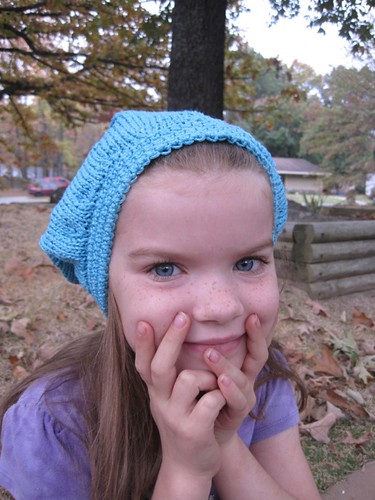
She just gets more beautiful every day, doesn't she?

She just gets more beautiful every day, doesn't she?
Sunday, November 6, 2011
The giving box
Children want to give. Just like the rest of us. And just like the rest of us, children find it easy and inspiring to give when there is a process and a framework that helps them succeed.
At Sunday School a few weeks ago, Cady Gray heard about Operation Christmas Child. She asked if we could get one of the wrapped shoe boxes in the church vestibule and fill it with items for a child in need. It was easy to say yes, to pick up a box and a packet of instructions and labels.
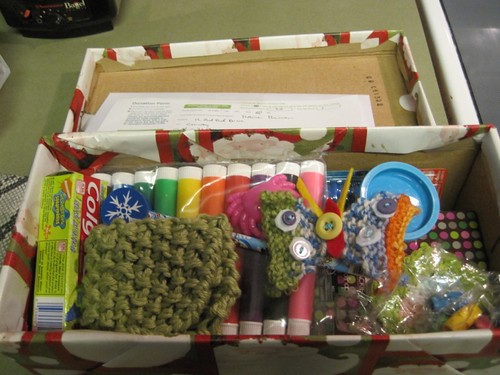
Cady Gray dug through our closet of unused art supplies and unopened toys to find notebooks, markers, a tub of play-doh, a small stuffed animals. She ran to the bathroom closet to retrieve toothpaste and toothbrushes from her trips to the dentist. She picked out festive pencils and erasers from our large supply. She asked if we could include a small shampoo and lotion, and a crocheted scrubbie from my stash of last-minute gifts.

She knit a colorful butterfly, using a pattern she knew well. I sewed on the felt pieces and buttons she picked out.
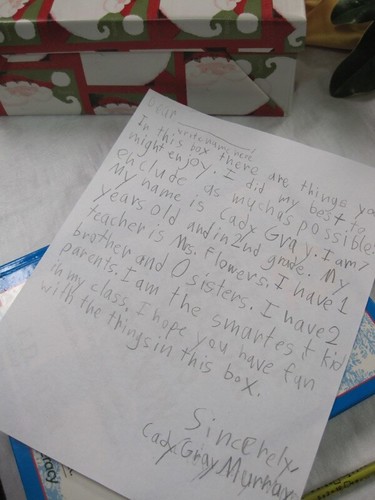
And right before we sealed up the box with our donation to cover shipping inside and the label identifying it as intended for a 5-9 year old boy outside, she decided she wanted to write a note to the recipient. Here's what she wrote:

A box, a list, a label, and the idea of a child just like her -- a child who loves to be creative, who takes baths and brushes his teeth, whose imagination can take flight on a butterfly's colorful wings -- is all it takes for Cady Gray to give. Just like the rest of us.
At Sunday School a few weeks ago, Cady Gray heard about Operation Christmas Child. She asked if we could get one of the wrapped shoe boxes in the church vestibule and fill it with items for a child in need. It was easy to say yes, to pick up a box and a packet of instructions and labels.

Cady Gray dug through our closet of unused art supplies and unopened toys to find notebooks, markers, a tub of play-doh, a small stuffed animals. She ran to the bathroom closet to retrieve toothpaste and toothbrushes from her trips to the dentist. She picked out festive pencils and erasers from our large supply. She asked if we could include a small shampoo and lotion, and a crocheted scrubbie from my stash of last-minute gifts.

She knit a colorful butterfly, using a pattern she knew well. I sewed on the felt pieces and buttons she picked out.

And right before we sealed up the box with our donation to cover shipping inside and the label identifying it as intended for a 5-9 year old boy outside, she decided she wanted to write a note to the recipient. Here's what she wrote:
Dear ________ (write name here),
In this box there are things you might enjoy. I did my best to enclude as much as possible. My name is Cady Gray. I am 7 years old and in 2nd grade. My teacher is Mrs. Flowers. I have 1 brother and 0 sisters. I have 2 parents. I am the smartest kid in my class. I hope you have fun with the things in this box.
Sincerely,
Cady Gray Murray

A box, a list, a label, and the idea of a child just like her -- a child who loves to be creative, who takes baths and brushes his teeth, whose imagination can take flight on a butterfly's colorful wings -- is all it takes for Cady Gray to give. Just like the rest of us.
Saturday, November 5, 2011
The STEM race
This article from the New York Times details reports showing that 40 percent of college students who set out to earn degrees in science and engineering end up shifting their majors away from those fields or dropping out of school altogether. When you add in students intending to go pre-med, the number increases to a whopping 60 percent -- "twice the combined attrition rate of all other majors." Students who go to more selective schools (and presumably have better scores and records) actually fail to get their intended science and engineering degrees at a higher rate than those at less selective schools.
The numbers come as no surprise to me or my colleagues in Honors education. The natural sciences account for most of the major intentions of our incoming freshmen, but that number drops precipitously after the first and second years, and the other academic concentrations -- humanities, arts, social sciences -- rise in proportion. Because our job is stemming the tide of high-ability students dropping out of the university (often because their GPA drops below the level needed to maintain their scholarships), we spend a lot of our advising time trying to get them to read the handwriting on their report cards -- those C's in early science and math courses will not translate into a spot in grad school. Add to those the students who find the courses grueling -- those who are having their passion for the field beat out of them by lectures, high-stakes machine-graded exams, and abstracted practice exercises -- and that 60% is within sight.
Interesting, too, how some universities are cutting those numbers down in half: by breaking up large lecture classes, creating project-based learning in the early years (not just at the capstone), and lowering the grade stakes. That will sound familiar to folks in Honors education.
We don't have an engineering school or a specific pre-engineering curriculum at my university, and that's a boon for my job, since it means I don't have to dedicate a chunk of my energy to warning the brilliant and broadly engaged students in my program away from engineering as a field. As the article intimates, bright students find engineering narrow, dull, and unconnected to their dreams of improving people's lives. And that's a terrible shame, since the world needs brilliant and broadly engaged engineers. Unfortunately, the field is best known among undergraduate mentors and advisers like me for its female-hostile workplaces and sometimes proudly backwards attitudes toward the life of the mind. Have you read about a Doctor So-and-so who is tearing it up on the climate-denial or creationist circuit? Check to see if that doctorate is in engineering.
We in higher education need to do better. Some will cluck that efforts to ease the way toward these degrees amounts to lowering standards, but that's patently not the case. These students are capable and interested, but the way we're teaching them is driving them away. It's not just because of the global competition for these jobs and this expertise that we need to do better; it's because the problems that face us frequently demand a response from these fields, and without the best minds of the upcoming generation to confront them, we're fighting at half strength or less.
The numbers come as no surprise to me or my colleagues in Honors education. The natural sciences account for most of the major intentions of our incoming freshmen, but that number drops precipitously after the first and second years, and the other academic concentrations -- humanities, arts, social sciences -- rise in proportion. Because our job is stemming the tide of high-ability students dropping out of the university (often because their GPA drops below the level needed to maintain their scholarships), we spend a lot of our advising time trying to get them to read the handwriting on their report cards -- those C's in early science and math courses will not translate into a spot in grad school. Add to those the students who find the courses grueling -- those who are having their passion for the field beat out of them by lectures, high-stakes machine-graded exams, and abstracted practice exercises -- and that 60% is within sight.
Interesting, too, how some universities are cutting those numbers down in half: by breaking up large lecture classes, creating project-based learning in the early years (not just at the capstone), and lowering the grade stakes. That will sound familiar to folks in Honors education.
We don't have an engineering school or a specific pre-engineering curriculum at my university, and that's a boon for my job, since it means I don't have to dedicate a chunk of my energy to warning the brilliant and broadly engaged students in my program away from engineering as a field. As the article intimates, bright students find engineering narrow, dull, and unconnected to their dreams of improving people's lives. And that's a terrible shame, since the world needs brilliant and broadly engaged engineers. Unfortunately, the field is best known among undergraduate mentors and advisers like me for its female-hostile workplaces and sometimes proudly backwards attitudes toward the life of the mind. Have you read about a Doctor So-and-so who is tearing it up on the climate-denial or creationist circuit? Check to see if that doctorate is in engineering.
We in higher education need to do better. Some will cluck that efforts to ease the way toward these degrees amounts to lowering standards, but that's patently not the case. These students are capable and interested, but the way we're teaching them is driving them away. It's not just because of the global competition for these jobs and this expertise that we need to do better; it's because the problems that face us frequently demand a response from these fields, and without the best minds of the upcoming generation to confront them, we're fighting at half strength or less.
Friday, November 4, 2011
When knitters take over the world
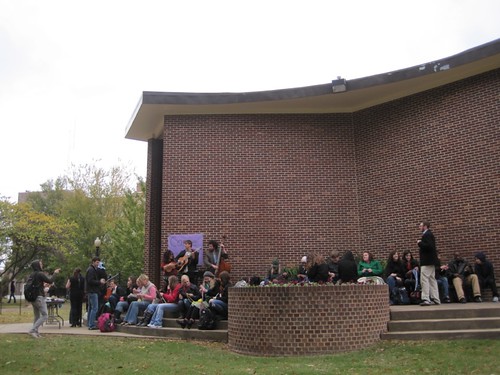
This is what it will look like when knitters take over the world.
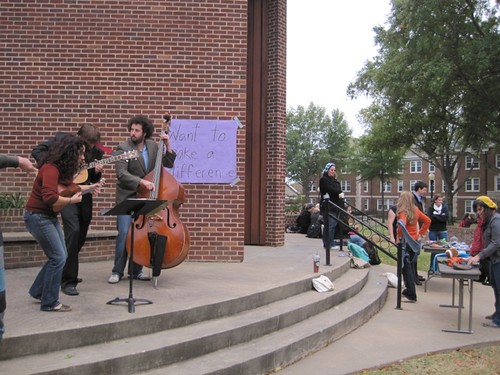
We'll have music.
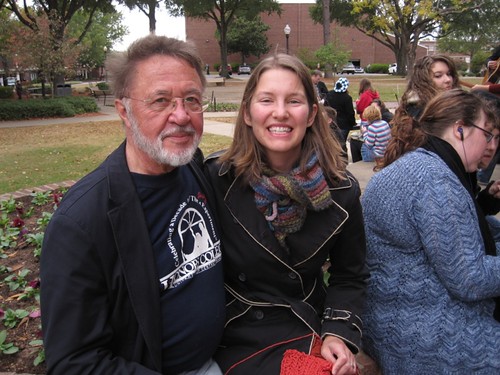
Young, old, and inbetween will work together.
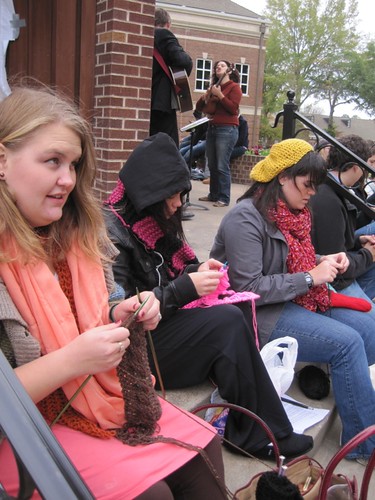
Everything will be bursting with color.
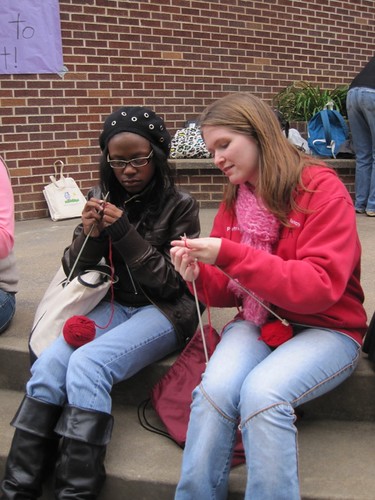
Anyone is welcome to learn.
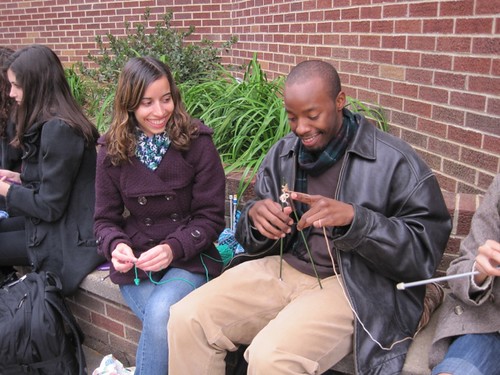
Anyone can become a teacher.

We'll have the cutest accessories.
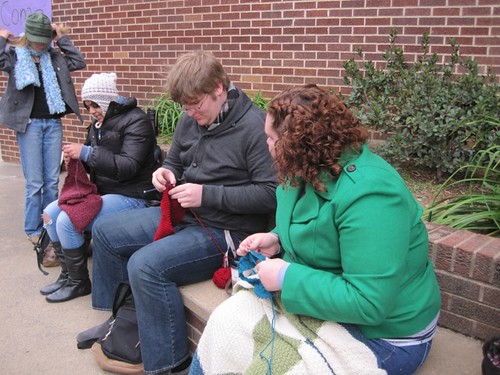
Everyone will stay warm and cozy.

What we do will have meaning.
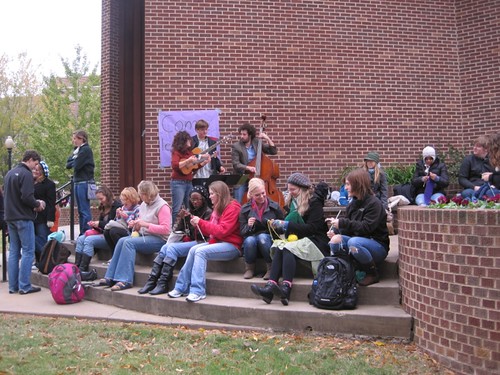
What we do will connect us -- to our community ...

... and to each other.
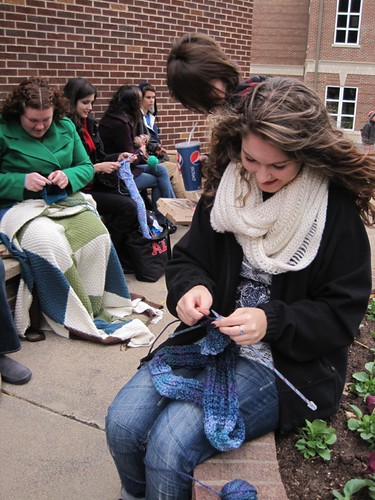
When knitters take over the world, the world will be more beautiful.
Scenes from the second Craft-In for CASA, Ferguson Chapel, University of Central Arkansas, November 3, 2011. For more information, visit facebook.com/CraftinForCASA.
Thursday, November 3, 2011
Counting on your fingers
This week I've been immersed in the world of writing. I've gone to two readings, one of creative nonfiction and one of poetry, and naturally I've knit my way through both.
As I listened to the writers read their work and talk about their craft, I thought about Gwyneth Lewis's "How To Knit A Poem," which I've read aloud on several occasions, which brings the two crafts together in an interesting analogy. But when the poet reading tonight talked about being the queen of writer's block, I realized the difference.
Knitters might get blocked when finishing or starting a piece; they might lose their motivation or drive; but knitting itself can't be blocked. The stitches sit there on the needle waiting. All you have to do is put the needle in and pull the yarn through.
Writing is simple in a way. It's just language. We compose every day in our speech. But in another way, in the terror-of-the-blank-page way, it's so difficult. You have to choose.
Knitting is simple in a different way. There are choices about what texture and shape to create. But each stitch is almost automatic. There's no hesitation. You just work it. A second, a few gestures, a swoop and lift that looks almost magical from without, and it is done. The next second, the next stitch. Easy.
Today fifty or so knitters sat outside in the chilly west wind and went stitch by stitch. They built for one hour, row on row, second by second, passerby by passerby.
Imagine a write-in where poets sat on those same steps and wrote poetry. They could force themselves to never stop writing for the whole hour, producing pieces that mapped the time by words -- I've done exercises like that. They can be wonderful and illuminating to those who participate and witness.
But when knitters do it, it's not an exercise. It's just knitters knitting. En masse and outside and for a specified period of time, but otherwise no different from what we do. There's something about it that makes the whole thing mathematical. I knit for an hour outside. Multiply me by fifty. That's how much knitting happened. That's what people saw when they walked past.
It was that simple. That ordinary. But multiply ordinary by fifty and put it in the middle of campus and just keep going, and maybe it becomes profound. A poem that writes itself every second.
As I listened to the writers read their work and talk about their craft, I thought about Gwyneth Lewis's "How To Knit A Poem," which I've read aloud on several occasions, which brings the two crafts together in an interesting analogy. But when the poet reading tonight talked about being the queen of writer's block, I realized the difference.
Knitters might get blocked when finishing or starting a piece; they might lose their motivation or drive; but knitting itself can't be blocked. The stitches sit there on the needle waiting. All you have to do is put the needle in and pull the yarn through.
Writing is simple in a way. It's just language. We compose every day in our speech. But in another way, in the terror-of-the-blank-page way, it's so difficult. You have to choose.
Knitting is simple in a different way. There are choices about what texture and shape to create. But each stitch is almost automatic. There's no hesitation. You just work it. A second, a few gestures, a swoop and lift that looks almost magical from without, and it is done. The next second, the next stitch. Easy.
Today fifty or so knitters sat outside in the chilly west wind and went stitch by stitch. They built for one hour, row on row, second by second, passerby by passerby.
Imagine a write-in where poets sat on those same steps and wrote poetry. They could force themselves to never stop writing for the whole hour, producing pieces that mapped the time by words -- I've done exercises like that. They can be wonderful and illuminating to those who participate and witness.
But when knitters do it, it's not an exercise. It's just knitters knitting. En masse and outside and for a specified period of time, but otherwise no different from what we do. There's something about it that makes the whole thing mathematical. I knit for an hour outside. Multiply me by fifty. That's how much knitting happened. That's what people saw when they walked past.
It was that simple. That ordinary. But multiply ordinary by fifty and put it in the middle of campus and just keep going, and maybe it becomes profound. A poem that writes itself every second.
Wednesday, November 2, 2011
La ci darem la mano
On Sunday I went to a theatrical presentation of the Metropolitan Opera's production of Don Giovanni -- one of those live-in-HD broadcasts on the giant screen, only not at my local movie theater but in the performing arts main stage on our campus.
We had worked with the College of Fine Arts and Communications to get discounted tickets for our freshmen in the hope of introducing them to the opera series offered on campus. The choice of opera couldn't have been more felicitous for me. Don Giovanni is one of the few operas with resonance in my upbringing.
I'll never forget the unit on Don Giovanni that my beloved high school mentor Mrs. Greene taught in ninth grade music. She played and replayed "La ci darem la mano" so we could understand the simple melody and structure, and the subtle way Mozart changes it as the duet progresses.
She also impressed my teenage mind indelibly with the plot of the final act: A graveyard statue comes to life and drags Don Giovanni down to hell for his sins! I admit that throughout the broadcast on Sunday I was giddy with anticipation for that part. What could be more awesome?
What I'm wondering is whether productions usually play Donna Anna and her fiance straight, or whether they are ever played as comic buffoons. Their asides to the audience about how confused they are, not to mention the way Donna Anna always pleads grief and revenge in order to avoid committing to Don Ottavio, make me think that the whole thing could be a pretty hilarious joke. Any opera aficionados care to enlighten me?
We had worked with the College of Fine Arts and Communications to get discounted tickets for our freshmen in the hope of introducing them to the opera series offered on campus. The choice of opera couldn't have been more felicitous for me. Don Giovanni is one of the few operas with resonance in my upbringing.
I'll never forget the unit on Don Giovanni that my beloved high school mentor Mrs. Greene taught in ninth grade music. She played and replayed "La ci darem la mano" so we could understand the simple melody and structure, and the subtle way Mozart changes it as the duet progresses.
She also impressed my teenage mind indelibly with the plot of the final act: A graveyard statue comes to life and drags Don Giovanni down to hell for his sins! I admit that throughout the broadcast on Sunday I was giddy with anticipation for that part. What could be more awesome?
What I'm wondering is whether productions usually play Donna Anna and her fiance straight, or whether they are ever played as comic buffoons. Their asides to the audience about how confused they are, not to mention the way Donna Anna always pleads grief and revenge in order to avoid committing to Don Ottavio, make me think that the whole thing could be a pretty hilarious joke. Any opera aficionados care to enlighten me?
Tuesday, November 1, 2011
Subscribe to:
Posts (Atom)


